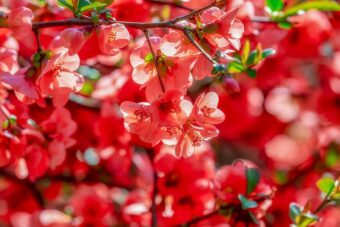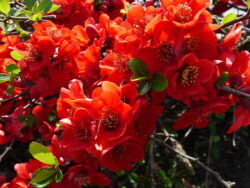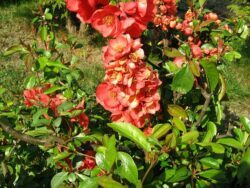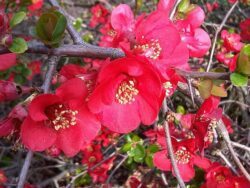In this article, we will discuss how to grow the colourful shrub of Chaenomeles in containers. Chaenomeles is a small species of deciduous shrubs that can grow up to 3m tall, all having spines. They are closely related to Chinese Quince (Pseudocydonia sinensis) but differ in degree of serration and leaf fuzz. It is a member of the Rosaceae (the Rose) family.

Chaenomeles is an old favourite and you will find it growing in many gardens throughout the UK. The green leaves are simple, oval, alternately arranged and have serrated margins. They are nothing special but the large 4.5cm flowers that are produced in spring are. The five-petal blooms are usually orange/red but they can be white or pink. After flowering, the quince fruit appears that ripens in late autumn. The fruits are edible but nothing special so do not get your hopes up too high unless you like making jams and jellies.
Find out how to grow Chaenomeles in containers in the article.
GROWING CHAENOMELES IN CONTAINERS
You will need to grow Chaenomeles in a large container with plenty of drainage holes at the bottom. To this add a 2cm layer of gravel to the bottom of the container to aid drainage further. On top of the gravel, add up to 5cm below the rim multipurpose compost.
Dig a hole at the centre of the container slightly larger than the root ball it came in the original container. Drop the plant on so that the top of the root ball is at the same level as the top surface of the compost. Backfill with the growing media making sure that no gaps remain, using more compost if necessary. Firm the plant in and water well.
CARE OF CHAENOMELES
You will need to place your plant and container in full sun or partial shade but it is a very hardy plant.
You will need to water frequently during dry and hot summer until it is well-established. After that, you will need to water when 5cm below the top surface of the compost feels dry to the touch. Water until it emerges from the drainage holes.
Every spring it is advised to give an annual dressing with a slow-release general-purpose fertilizer to give enough nutrients to least through the growing season. To give an extra boost, you can add a handful of potash to give a better quality of fruits if you are growing Chaenomeles for its fruits to make jams and jellies.
YOU CAN GROW THEM FOR THE FRUIT

If you are growing for its fruit then it may be worth growing them against a wall, where the branches can be trained. They will grow taller this way and will not grow tangled and untidy. When harvesting the fruit in late autumn, make sure the fruit is yellow and soft to the touch; otherwise, it will be inedible.
If you grow them au natural in a bush form then you can let them be and they will not need any pruning. If you are growing them as a fan, you will need to remove straggly, weak and crowded shots after it has finished flowering. Make sure you wear gloves whilst doing so.
You can prune hard to regenerate the shrubs if it becomes too large or too unsightly. The result will be most autumn fruit will be lost if this is done. To avoid this leave some good and strong flowering stems to give fruit, which can be pruned the following year.
To train against a wall in a fan-like pattern, you can remove any shoots that grow at a right angle to the wall.
If you wish to propagate, you can take and pull semi-ripe cuttings in summer and overwinter them in a cold frame. You can then plant them out the following spring. You can remove any root suckers in autumn and put these on for planting when they get a bit bigger.
PESTS AND DISEASES

They are not total pests and diseases-free as they can suffer from scales and aphids. This is best treated as soon as observed with suitable insecticides. You will need to be persistent as it may take some time to deal with these pests.
They may suffer from chlorosis if there is a lack of iron but this can be prevented if you feed with a balanced slow-release fertilizer that has iron in it. You can use sulphate of iron in spring as well.
If your bush suffers from fire blight, you may have to destroy it, especially if it is very bad.
VARIETIES TO GROW
There are two main species that are often grown in the UK:

Chaenomeles speciosa is often branched and sparsely leaved, making it a good wall plant. Varieties to look for is ‘Moerloosei’ with pale pink and white flowers, ‘Hot Fire’ with deep red flowers, ‘Nivalis’ with white large flowers, ‘Umbilicata’ that has deep pink flowers, ‘Simonii’ with its semi-double red flowers and the low growing ‘Yukigoten’ that has double white flowers.
Chaenomeles japonica is a smaller species only growing to 1m high and produces bright orange or red flowers over a long period from early spring. ‘Sargentii’ and ‘Alpine’ produces orange flowers in spring and aromatic golden fruits in autumn.
A cross between the two mentioned species will eventually create a dense, spreading bush. It comes in a variety of colours, including ‘Nicoline’ that produces red flowers, ‘Pink Lady’ that has pink flowers, ‘Knop Hill Scarlet’ produces orange-red flowers, ‘Hever Castle’ a shrimp pink, ‘Rowallena’ has deep crimson flowers and ‘Crimson and Gold’ that has deep red flowers with yellow anthers.
CONCLUSIONS
In this article, we have discussed how to grow the beautiful and useful shrub of Chaenomeles in containers. There are so many varieties available in lots of fiery colours that you did not realise that you can grow in containers.
They can be grown as a free shrub or against a wall or in a fan shape, which is best if you want to harvest the fruits. Easy to look after and easy to care for, so why not grow Chaenomeles in containers.
If you have any questions or comments that you wish to make on growing Chaenomeles on containers, please do so in the comment box below.
Happy Chaenomeles growing.
